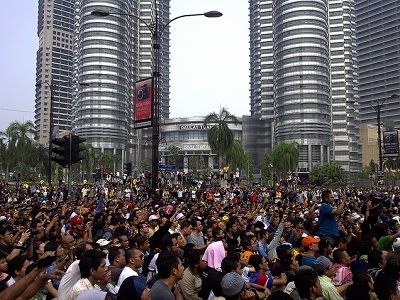The political impact of Bersih 2.0

The question that is now uppermost in the public imagination is whether the current government will also suffer a severe blow for its inept handling of the event.
Bersih’s first political rally on Nov 10, 2007 saw some 40,000 Malaysian streaming into the heart of Kuala Lumpur, setting a benchmark for peaceful political protest in Malaysia.
On July 9, 2011 almost the same number of demonstrators were out in the streets of Kuala Lumpur, as estimated by the independent “politweet”, despite a ban on the rally and police roadblocks at every point of entry into KL. If the political impact of Bersih 1.0 on the general election of March 2008 is now axiomatic, would Bersih 2.0 have a similar impact on the next general election?
It is important to first understand the character of the rally itself. The outpouring of material on the social media and through social networking websites reached proportions which, in my view, have been unprecedented and have not stopped. At the point of writing, over 200,000 facebookers have called on premier Najib Tun Razak to resign. The webpage has picked up 20,000 votes or more in one day.
The people who showed up at Bersih 2.0 came from a cross-section of Malaysia’s multicultural society, with Malays and youth as the dominant groups. This spoke well for the continuation of the trajectory of Malaysia’s non-racialised “new politics”. The involvement of national literary laureate A Samad Said who wrote a touching poem about Malaysia’s “wounded democracy” was highly inspiring to the would-be Bersih rallyers.
Various attempts made to delegitimise Bersih by Umno-related groups had a counter-productive effect. Thus it was alleged that it would be “unIslamic” for Muslims to participate in an illegal rally. The bogey of May 13 was also invoked and the Chinese were asked to stock up on food and stay at home. Such racialisation of the event by Perkasa and the Malay paper Utusan Malaysia helped to further augment multiracial supporters on the other side. The lame counter march of a couple of hundreds of Umno Youth “patriots” proved to be the proverbial drop in the bucket in terms of its impact.
The event received a crucial boost when Suhakam chairman Hasmy Agam weighed in to opine that it was legitimate. Najib had called for the rally to be held at a stadium and the organisers obliged after meeting with the King but the police were adamant about not giving a permit for use of the Merdeka Stadium.
The heavy-handed action on the part of the police – some 1,700 arrests, heavy use of tear gas, water cannons, and some argue, responsibility for one death – has put the government in a no-win situation vis-à-vis the common Malaysian citizen.
BN in damage control mode
In public imagination, Bersih 2.0 would stand out even more than Bersih 1. Already folklore about Bersih has gone “viral” on the Internet. A few examples should suffice. “The Lady of Liberty”, an elderly woman well into her 60s, who braved the water cannons, holding a branch with two daisies has been reproduced ad infinitum in multiple incarnations and web designs.

